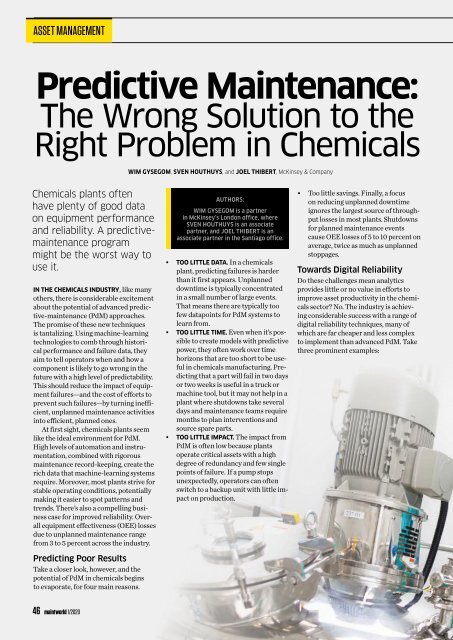Maintworld 1/2020
ROTATING EQUIPMENT SERVICES: A COMPREHENSIVE, WORRY-FREE PACKAGE // SELF-INFLICTED RELIABILITY PROBLEMS OF ROTATING MACHINERY // VIEWING MAINTENANCE AS A SYSTEM TO OPTIMIZE PERFORMANCE
ROTATING EQUIPMENT SERVICES: A COMPREHENSIVE, WORRY-FREE PACKAGE // SELF-INFLICTED RELIABILITY PROBLEMS OF ROTATING MACHINERY // VIEWING MAINTENANCE AS A SYSTEM TO OPTIMIZE PERFORMANCE
You also want an ePaper? Increase the reach of your titles
YUMPU automatically turns print PDFs into web optimized ePapers that Google loves.
ASSET MANAGEMENT<br />
Predictive Maintenance:<br />
The Wrong Solution to the<br />
Right Problem in Chemicals<br />
WIM GYSEGOM, SVEN HOUTHUYS, and JOEL THIBERT, McKinsey & Company<br />
Chemicals plants often<br />
have plenty of good data<br />
on equipment performance<br />
and reliability. A predictivemaintenance<br />
program<br />
might be the worst way to<br />
use it.<br />
IN THE CHEMICALS INDUSTRY, like many<br />
others, there is considerable excitement<br />
about the potential of advanced predictive-maintenance<br />
(PdM) approaches.<br />
The promise of these new techniques<br />
is tantalizing. Using machine-learning<br />
technologies to comb through historical<br />
performance and failure data, they<br />
aim to tell operators when and how a<br />
component is likely to go wrong in the<br />
future with a high level of predictability.<br />
This should reduce the impact of equipment<br />
failures—and the cost of efforts to<br />
prevent such failures—by turning inefficient,<br />
unplanned maintenance activities<br />
into efficient, planned ones.<br />
At first sight, chemicals plants seem<br />
like the ideal environment for PdM.<br />
High levels of automation and instrumentation,<br />
combined with rigorous<br />
maintenance record-keeping, create the<br />
rich data that machine-learning systems<br />
require. Moreover, most plants strive for<br />
stable operating conditions, potentially<br />
making it easier to spot patterns and<br />
trends. There’s also a compelling business<br />
case for improved reliability. Overall<br />
equipment effectiveness (OEE) losses<br />
due to unplanned maintenance range<br />
from 3 to 5 percent across the industry.<br />
Predicting Poor Results<br />
Take a closer look, however, and the<br />
potential of PdM in chemicals begins<br />
to evaporate, for four main reasons.<br />
AUTHORS:<br />
WIM GYSEGOM is a partner<br />
in McKinsey’s London office, where<br />
SVEN HOUTHUYS is an associate<br />
partner, and JOEL THIBERT is an<br />
associate partner in the Santiago office.<br />
• TOO LITTLE DATA. In a chemicals<br />
plant, predicting failures is harder<br />
than it first appears. Unplanned<br />
downtime is typically concentrated<br />
in a small number of large events.<br />
That means there are typically too<br />
few datapoints for PdM systems to<br />
learn from.<br />
• TOO LITTLE TIME. Even when it’s possible<br />
to create models with predictive<br />
power, they often work over time<br />
horizons that are too short to be useful<br />
in chemicals manufacturing. Predicting<br />
that a part will fail in two days<br />
or two weeks is useful in a truck or<br />
machine tool, but it may not help in a<br />
plant where shutdowns take several<br />
days and maintenance teams require<br />
months to plan interventions and<br />
source spare parts.<br />
• TOO LITTLE IMPACT. The impact from<br />
PdM is often low because plants<br />
operate critical assets with a high<br />
degree of redundancy and few single<br />
points of failure. If a pump stops<br />
unexpectedly, operators can often<br />
switch to a backup unit with little impact<br />
on production.<br />
• Too little savings. Finally, a focus<br />
on reducing unplanned downtime<br />
ignores the largest source of throughput<br />
losses in most plants. Shutdowns<br />
for planned maintenance events<br />
cause OEE losses of 5 to 10 percent on<br />
average, twice as much as unplanned<br />
stoppages.<br />
Towards Digital Reliability<br />
Do these challenges mean analytics<br />
provides little or no value in efforts to<br />
improve asset productivity in the chemicals<br />
sector? No. The industry is achieving<br />
considerable success with a range of<br />
digital reliability techniques, many of<br />
which are far cheaper and less complex<br />
to implement than advanced PdM. Take<br />
three prominent examples:<br />
46 maintworld 1/<strong>2020</strong>

















